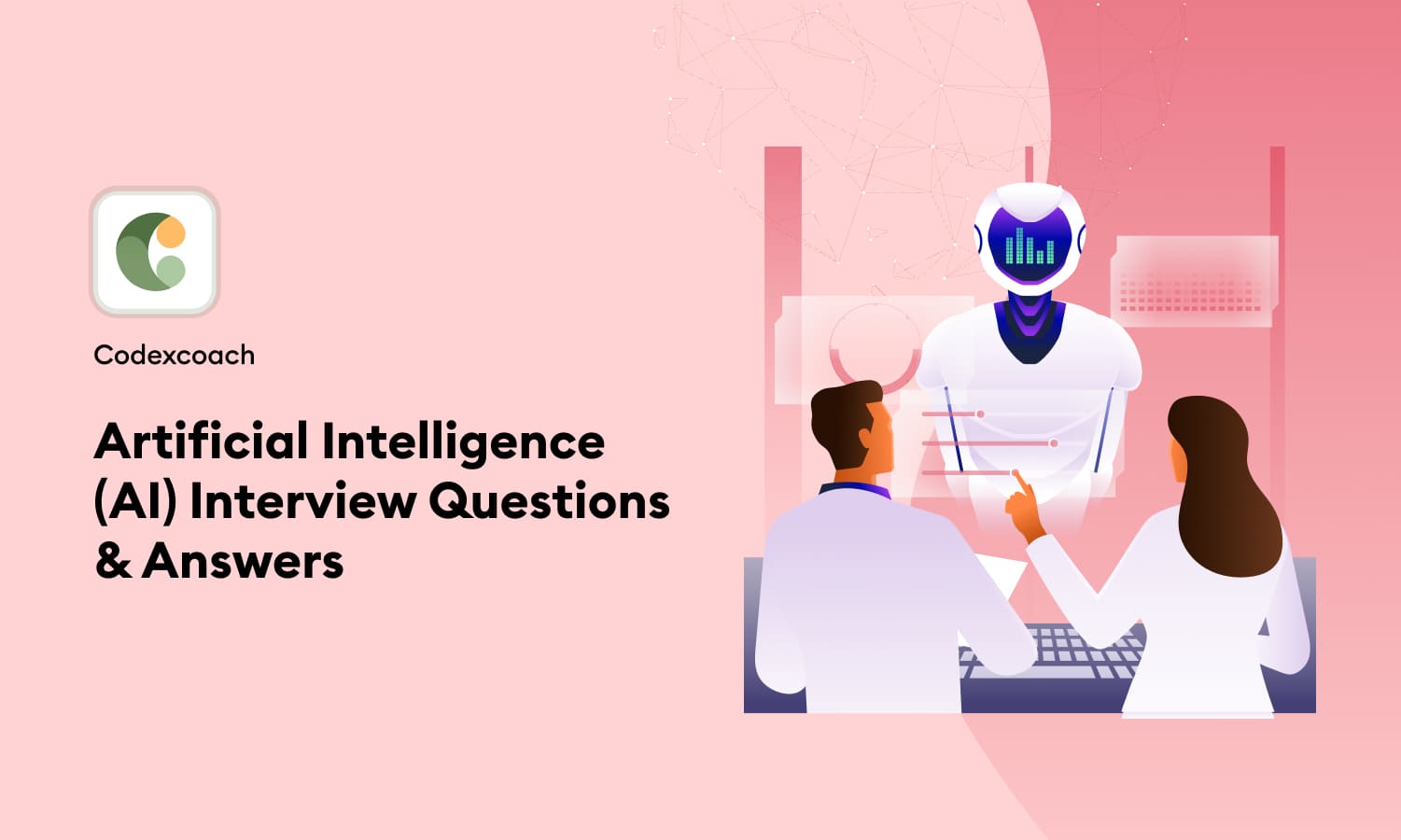Preparing for an interview in the field of artificial intelligence (AI) can be challenging due to the broad spectrum of topics it encompasses. From understanding the basics of machine learning algorithms to discussing complex AI ethics, it’s essential to be well-rounded. Here’s a structured list of potential interview questions along with concise answers to help you prepare.
1. What is Artificial Intelligence?
Answer: Artificial Intelligence (AI) refers to the simulation of human intelligence in machines that are programmed to think and learn like humans. The term can also apply to any machine that exhibits traits associated with a human mind, such as learning and problem-solving.
2. Can you explain the difference between AI, Machine Learning, and Deep Learning?
Answer:
- Artificial Intelligence is a broad area of computer science focused on creating smart machines capable of performing tasks that typically require human intelligence.
- Machine Learning is a subset of Artificial Intelligence that includes techniques allowing machines to improve at tasks with experience.
- Deep Learning is a subset of Machine Learning that uses neural networks with many layers (hence “deep”) to learn from large amounts of data.
3. What are neural networks?
Answer: Neural networks are algorithms, modeled loosely after the human brain, that are designed to recognize patterns. They interpret sensory data through a kind of machine perception, labeling, or clustering of raw input. They are the foundation of deep learning and are particularly useful for tasks like image recognition, speech recognition, and natural language processing.
4. What is supervised learning?
Answer: Supervised learning is a type of machine learning where the algorithm is trained on a labeled dataset, meaning that each training example is paired with an output label. The algorithm makes predictions or decisions based on input data and is corrected when its predictions are incorrect.
5. What is unsupervised learning?
Answer: Unsupervised learning involves training an algorithm on data without labeled responses. The system tries to learn the patterns and the structure from the data without any explicit instructions on what to predict. It’s used for clustering, association, and dimensionality reduction on datasets where we only have input data and no corresponding output variables.
6. What are the main challenges of Artificial Intelligence?
Answer:
- Data Privacy: Ensuring the privacy and security of the data used to train Artificial Intelligence systems.
- Bias: Addressing bias in Artificial Intelligence algorithms, which can arise from biased training data or the algorithm itself.
- Explainability: Developing Artificial Intelligence systems that can explain their decisions and actions to human users.
- Ethical and Societal Impact: Considering the ethical implications and societal impacts of Artificial Intelligence technology, including job displacement and the potential for misuse.
7. How do you ensure an Artificial Intelligence system is ethical?
Answer: Ensuring an Artificial Intelligence system is ethical involves several steps:
- Implement ethical guidelines and principles in the design and development process.
- Use diverse and unbiased data to train models to prevent biased outcomes.
- Regularly audit and review Artificial Intelligence systems to assess their impact and make necessary adjustments.
- Engage with stakeholders, including ethicists, to evaluate the ethical implications of Artificial Intelligencesystems.
8. What is reinforcement learning?
Answer: Reinforcement learning is a type of machine learning where an agent learns to make decisions by taking actions in an environment to achieve some objectives. The agent is rewarded or penalized for the actions it takes, and its goal is to maximize the total reward.
9. What is a Convolutional Neural Network (CNN)?
Answer: A Convolutional Neural Network (CNN) is a deep learning algorithm that can take in an input image, assign importance (learnable weights and biases) to various aspects/objects in the image, and be able to differentiate one from the other. The preprocessing required in a CNN is much lower as compared to other classification algorithms. These networks are particularly useful for image recognition and processing tasks due to their ability to efficiently manage spatial hierarchy in data.
10. Explain the concept of Transfer Learning.
Answer: Transfer Learning is a research problem in machine learning that focuses on storing knowledge gained while solving one problem and applying it to a different but related problem. For example, knowledge gained while learning to recognize cars could apply when trying to recognize trucks. It’s especially useful in deep learning models, where training from scratch requires a lot of data and computational power. By using a pre-trained model and fine-tuning it for a slightly different task, we can achieve high accuracy with significantly less data and training time.
11. What is Natural Language Processing (NLP)? Give an example of its application.
Answer: Natural Language Processing (NLP) is a field of artificial intelligence that gives machines the ability to read, understand, and derive meaning from human languages. It involves the interaction between computers and humans using the natural language. An example of NLP in action is chatbots. Chatbots use NLP to understand user requests and provide relevant responses, simulating a conversation with a human.
12. Describe the concept of Overfitting and how can you avoid it?
Answer: Overfitting occurs when a machine learning model learns the detail and noise in the training data to the extent that it negatively impacts the model’s performance on new data. This means the model is too complex, capturing noise in the data rather than the intended outputs. To avoid overfitting, techniques like cross-validation, pruning, regularization, and early stopping can be employed. Additionally, gathering more training data or reducing the complexity of the model can also help.
13. What is Generative Adversarial Network (GAN)?
Answer: A Generative Adversarial Network (GAN) consists of two models: a generative model and a discriminative model. The generative model is trained to generate new data points, and the discriminative model evaluates them. The models are trained simultaneously in a competitive manner; the generator aims to produce data indistinguishable from real data, while the discriminator aims to distinguish between real and generated data. This process improves both models until the generator produces highly realistic data. GANs are widely used for image generation, style transfer, and more.
14. How does a Decision Tree work?
Answer: A Decision Tree is a flowchart-like tree structure where an internal node represents a feature(or attribute), the branch represents a decision rule, and each leaf node represents the outcome. The topmost node in a decision tree is known as the root node. It learns to partition on the basis of the attribute value. It partitions the tree in a recursively manner called recursive partitioning. This method is popular for its simplicity and interpretability.
15. What are the ethical concerns associated with Artificial Intelligence?
Answer: The ethical concerns associated with AI include privacy issues, bias and discrimination in Artificial Intelligence decision-making, lack of transparency, job displacement due to automation, and the potential for AI-enhanced surveillance. There’s also concern over the development and use of autonomous weapons and the long-term existential risk posed by superintelligent AI systems. Addressing these concerns involves creating ethical guidelines for AI development and use, ensuring transparency and fairness in AI algorithms, and ongoing dialogue among technologists, policymakers, and the public.
16. What is the difference between Artificial Intelligence and Cognitive Computing?
Answer: AI is aimed at creating machines that can mimic human intelligence and perform tasks such as problem-solving and learning. Cognitive computing, on the other hand, is a subset of Artificial Intelligence that attempts to mimic human thought processes in a computerized model. The goal of cognitive computing is to create automated IT systems capable of solving problems without requiring human assistance. Cognitive computing systems use pattern recognition, data mining, and natural language processing to mimic the human brain.
17. Explain the concept of A/B Testing in the context of Artificial Intelligence.
Answer: A/B Testing, also known as split testing, is a method of comparing two versions of a webpage or app against each other to determine which one performs better. In the context of Artificial Intelligence, A/B testing can be used to compare different models or algorithms to see which one provides better outcomes on specific metrics such as click-through rates, conversion rates, or user engagement levels. It involves randomly showing the two versions to users and statistically analyzing the performance to decide which version is more effective.
18. What is Quantum Computing and how could it impact Artificial Intelligence?
Answer: Quantum Computing is a type of computing that takes advantage of the quantum states of subatomic particles to store information. Unlike traditional computers which use bits as the smallest unit of information (0 or 1), quantum computers use quantum bits or qubits, which can represent and store information in both 0 and 1 simultaneously. This ability to perform multiple calculations at once could potentially revolutionize Artificial Intelligence by providing the power to process complex datasets more efficiently than classical computers, leading to faster advancements in machine learning algorithms and Artificial Intelligence research.
19. Describe the concept of Feature Engineering and its importance in Machine Learning.
Answer: Feature Engineering is the process of using domain knowledge to extract features (characteristics, properties, attributes) from raw data that make machine learning algorithms work. It is a crucial step in the machine learning process because the right features can improve the performance of machine learning models significantly. By transforming and combining raw data into features that better represent the underlying problem, machine learning models can learn more effectively from the data, leading to more accurate predictions.
20. How can Artificial Intelligence be used to address climate change?
Answer: Artificial Intelligence can be leveraged in numerous ways to combat climate change, including:
- Climate Modeling and Prediction: Enhancing the accuracy of climate models to predict future climate conditions and assess the impact of various interventions.
- Energy Efficiency: Optimizing energy use in buildings, manufacturing, and transportation to reduce carbon emissions.
- Renewable Energy: Improving the efficiency of renewable energy sources such as solar and wind through better forecasting and integration into the power grid.
- Ecosystem Analysis: Monitoring ecosystems and biodiversity through data analysis to support conservation efforts and understand the impacts of climate change.
- Sustainable Agriculture: Using Artificial Intelligence to optimize agricultural practices, reduce waste, and improve crop yields with minimal environmental impact.
21. Discuss the role of ethics in Artificial Intelligence development and deployment.
Answer: Ethics plays a critical role in Artificial Intelligence development and deployment, ensuring that Artificial Intelligence technologies are developed and used in a way that is fair, transparent, and beneficial to society. Key ethical considerations include:
- Bias and Fairness: Ensuring Artificial Intelligence systems do not perpetuate or amplify social inequalities.
- Privacy: Protecting individuals’ data and privacy in AI applications.
- Transparency and Accountability: Making AI systems transparent so that their decisions can be understood and they are held accountable for their actions.
- Safety and Security: Ensuring AI systems are secure from malicious use and cannot cause harm.
- Societal Impact: Considering the broader societal impacts of AI, including employment, mental health, and social interactions. Developing ethical AI requires multidisciplinary collaboration, involving policymakers, technologists, ethicists, and the public to navigate the complex moral landscape AI presents.
22. Explain the concept of Edge Computing in the context of AI.
Answer: Edge Computing refers to the practice of processing data near the edge of the network, where the data is being generated, instead of in a centralized data-processing warehouse. In the context of AI, edge computing involves running AI algorithms directly on the hardware devices (like smartphones, IoT devices) at the edge of the network. This approach reduces latency, decreases bandwidth use, and allows for real-time decision-making by processing data locally without needing to send it back to a central server for analysis. It’s particularly useful in applications requiring rapid responses, such as autonomous vehicles, industrial automation, and smart cities.
23. What is Model Interpretability, and why is it important?
Answer: Model Interpretability refers to the ability to understand and explain how machine learning models make decisions or predictions. It’s crucial for several reasons:
- Trust: Users are more likely to trust and adopt AI systems if they understand how decisions are made.
- Debugging: Understanding the model’s decision-making process makes it easier to identify and correct errors.
- Compliance: In many industries, regulations require decisions made by AI to be explainable for legal and ethical reasons.
- Ethical Considerations: Interpretability helps ensure that AI systems do not reinforce biases or make unfair decisions.
24. How can AI contribute to personalizing education?
Answer: AI can significantly enhance personalized learning by adapting educational content to meet the unique needs, skills, and learning pace of each student. Some ways AI contributes to personalizing education include:
- Adaptive Learning Platforms: These platforms use AI to assess a student’s current understanding and skills, then adapt the curriculum in real-time to challenge the student appropriately.
- Intelligent Tutoring Systems: AI-driven tutoring systems can provide personalized feedback and guidance, similar to a human tutor, but scalable for widespread use.
- Automated Grading: AI can grade assignments and exams quickly, providing immediate feedback that is tailored to each student’s responses.
- Learning Analytics: AI tools analyze data on students’ learning habits and performances to identify areas where they may need additional support or resources.
25. Discuss the potential impact of AI on job markets.
Answer: The impact of AI on job markets is multifaceted, with potential for both job creation and displacement.
- Job Displacement: Automation and AI technologies can perform tasks more efficiently than human workers in certain sectors, leading to job displacement, particularly in manufacturing, transport, and administrative roles.
- Job Creation: AI also creates jobs, especially in AI development, maintenance, and oversight, as well as in industries that leverage AI to provide new services or improve efficiency.
- Job Transformation: Many jobs will transform rather than disappear, with AI taking over routine tasks and humans focusing on higher-value work that AI cannot perform, such as tasks requiring emotional intelligence, creativity, and complex decision-making. The overall impact will likely depend on factors including the rate of AI adoption, economic policies, and the ability of the workforce to adapt to new roles.
26. What is Federated Learning, and how does it address privacy concerns?
Answer: Federated Learning is a machine learning approach that allows a model to be trained across multiple decentralized devices or servers holding local data samples, without exchanging them. This method addresses privacy concerns by:
- Data Privacy: Since the data never leaves its original location, personal and sensitive information is better protected.
- Data Security: Reducing the need to centralize data decreases the risk of data breaches.
- Regulatory Compliance: It can help organizations comply with data protection regulations such as GDPR, as it minimizes the need to transfer personal data. Federated Learning thus enables AI models to learn from diverse data sources without compromising the privacy and security of the data involved.
27. What role does AI play in cybersecurity?
Answer: AI plays a critical role in enhancing cybersecurity through its ability to analyze vast amounts of data quickly and identify threats or anomalies that might indicate a security breach. AI systems can:
- Detect Anomalies: Identify unusual patterns that may signify a security threat.
- Predictive Analysis: Use historical data to predict potential future attacks.
- Automate Responses: Automatically respond to certain types of security incidents.
- Phishing Detection: Identify phishing attempts by analyzing the content and metadata of emails. AI’s continuous learning capabilities allow it to adapt to new and evolving cybersecurity threats, making it an invaluable tool in the defense against cyber attacks.
28. How does AI influence the field of genomics?
Answer: AI significantly impacts genomics by accelerating genetic analysis and understanding, which can lead to breakthroughs in personalized medicine and treatments. In genomics, AI can:
- Gene Sequencing: Speed up the analysis of gene sequences, identifying genetic mutations and links to diseases faster.
- Predictive Models: Create models that predict the likelihood of developing certain genetic conditions.
- Drug Development: Help in the discovery of new drugs by analyzing the genetic factors of diseases and predicting how different drugs will interact with genetic markers.
- Personalized Medicine: Tailor treatments to individual genetic profiles, improving the effectiveness of treatments and reducing side effects.
29. Discuss the concept of AI governance and its importance.
Answer: AI governance refers to the legal and ethical frameworks, policies, and guidelines that govern the development, deployment, and use of artificial intelligence technologies. It is crucial for several reasons:
- Ethical Use: Ensures that AI technologies are developed and used in ways that are ethical and align with societal values.
- Transparency and Accountability: Promotes transparency in AI algorithms and decision-making processes, ensuring that AI systems are accountable for their actions.
- Safety and Security: Ensures that AI systems are safe to use and secure from malicious attacks or misuse.
- Fairness and Inclusion: Aims to prevent bias in AI systems and ensure that they are fair and inclusive to all segments of society. AI governance is essential for building trust in AI technologies and ensuring they contribute positively to society.
30. What is Explainable AI (XAI) and why is it critical?
Answer: Explainable AI (XAI) refers to methods and techniques in the field of artificial intelligence that make the results and operations of AI systems understandable to humans. XAI is critical because:
- Trust: Increases user trust in AI systems by making their operations transparent.
- Debugging and Improvement: Makes it easier to diagnose and fix errors in AI models.
- Regulatory Compliance: Helps meet legal and ethical standards requiring that AI decisions be explainable.
- Ethical Decision Making: Ensures that AI-driven decisions can be reviewed and evaluated for fairness, reducing the risk of bias and discrimination.
31. How does AI impact the creative industries?
Answer: AI has a profound impact on the creative industries by enabling new forms of creativity and enhancing the creative process. Examples include:
- Content Creation: AI can generate music, write stories, create artwork, and even develop video games, pushing the boundaries of traditional content creation.
- Enhancing Creativity: AI tools can suggest variations and improvements, helping artists and creators refine their work.
- Automation of Repetitive Tasks: AI can automate repetitive aspects of the creative process, allowing creators to focus on more innovative aspects of their work.
- Personalized Content: AI can tailor content to individual preferences, creating more engaging and personalized experiences for audiences. AI in the creative industries fosters innovation, offering both opportunities and challenges regarding originality and copyright.
32. What challenges does AI face in healthcare?
Answer: While AI has the potential to transform healthcare, it faces several challenges, including:
- Data Privacy and Security: Protecting sensitive health information while using AI to analyze data.
- Bias and Fairness: Ensuring AI algorithms do not perpetuate or introduce bias in healthcare decisions.
- Interoperability: Integrating AI with existing healthcare systems and ensuring they can work together seamlessly.
- Regulatory Approval: Navigating the complex regulatory landscape for healthcare technologies.
- Trust and Adoption: Gaining the trust of healthcare professionals and patients in AI tools.
- Ethical Considerations: Making ethically sound decisions, especially in critical care and patient treatment scenarios. Overcoming these challenges requires careful consideration of ethical, technical, and regulatory issues to fully realize AI’s benefits in healthcare.





